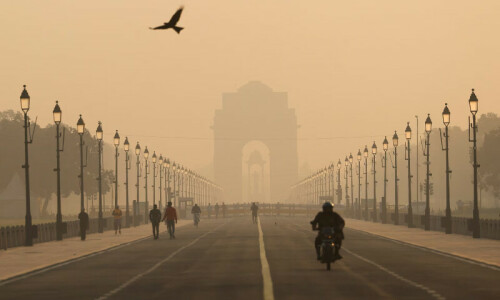A pilot project for lining a 10km segment of the Rohri Canal — known as the mini Indus — has been completed within the stipulated time at a cost of Rs3.1bn, according to the Sindh irrigation department.
The canal, considered a lifeline for the province’s agriculture sector, irrigates 2.6m acres of agriculture land on the left bank of the Indus.
The reaches between RD-619 to RD-647 of the Rohri Canal have been lined. The lining of the 219-mile or 352km long canal becomes all the more important as it irrigates farmlands that produce huge quantities of major crops like sugarcane, rice, cotton and wheat.
The lining project was designed to overcome water shortage in the tail-end reaches, as well as to avoid wastage, overcome salinity and water logging, reclaim around 5,000 acres of land, and save 200 cusecs of water that is sufficient to irrigate 60,000 acres of land.
The main concrete work of the pilot project was completed in 20 days, during the closure of the barrage. It took authorities another 10 days after the project’s completion to make the canal operational. It is now operating smoothly, according to Rohri Canal’s Superintending Engineer, Saeed Jagirani.
The importance and urgency of lining the main canals in Sindh is underlined by the fact that the province is at the tail-end of the country’s river system and confronted with serious issues relating to water availability.
The present irrigation network is a legacy of the colonial era. The lining of canals is considered vital for the existing system’s upkeep, notwithstanding the huge cost it involves. Nor can the fact be ignored that water conservation is increasingly assuming importance in Sindh owing to changing weather patterns and the brackish groundwater in the province. Owing to evaporation, conveyance losses remain too high at the main canals, branches, distributaries, minors and watercourses.
The lining project was designed to overcome water shortage in the tail-end reaches, as well as to avoid wastage, overcome salinity and water logging, reclaim around 5,000 acres of land and save 200 cusecs of water
Former Sndh irrigation secretary Idris Rajput, while discussing Rohri Canal’s lining, recently quoted the findings of the Planning Commission which indicated that 15pc of the water losses are assessed at the main canals, 8pc at branches, 30pc at watercourses and another 30pc at farmlands that are uneven or not laser levelled.
The lining of canals might not be advisable in areas where the groundwater is sweet, as the lined channels affect the recharge of groundwater. But wherever groundwater is brackish, it becomes necessary to ensure optimum use of water resources that are fast depleting.
Lining is also essential for Sindh’s irrigation network, which is deteriorating with each passing day. Floods in 2010 and 2011 had caused serious damage to the irrigation network and forced the federal and provincial governments to spend several billion rupees on the system’s rehabilitation.
Sindh has, in all, 14 main canals that take off from three barrages. Besides, a flood channel, Rainee Canal, is under construction at the Guddu Barrage.
“In a few years we’ll be able to achieve 100pc lining of perennial canals like Rohri and Nara. Their lining in one go is impossible,” says an irrigation officer.
Lined canals (concrete work) blocks seepage and improve the flow rate of water. The conveyance efficiency of unlined canals in sandy soil, according to some researchers, is around 75pc, and can improve to 90- 95pc provided the quality of lining is of high standard; otherwise it may drop to 70pc.
“It is indeed very important that canals should be lined. For such a giant project, the Sindh government can approach the federal government for financial assistance; it can’t single-handedly afford it,” argued Mahmood Nawaz Shah, vice president of the Sindh Abadgar Board.
During the Musharraf regime, under the National Programme for Improvement of Watercourses (NPIW), 23,000 watercourses were to be lined. But this project remains incomplete so far. Wherever watercourses have been lined, efficiency has improved significantly.
An officer of the Pakistan Council of Research in Water Resources, Ahmed Zeeshan Bhatti, points out that the Indira Gandhi Canal lining project in India converted desert wastelands into agriculturally productive areas. In Australia, piped water is supplied to farms to do away with evaporation losses.
“In the developed world, experts are now talking about controlling evaporation losses as the lining of channels is something that was done a long time ago.”
It is the quality of work that remains crucial during the lining of canals, branches or distributaries. High velocity of water in the bed improves water flows in lined canals. But if the quality remains below par, it can easily erode the canal bed or cause a breach, and sometimes become more dangerous than the unlined channels.
Published in Dawn, Economic & Business, March 2nd , 2015
On a mobile phone? Get the Dawn Mobile App: Apple Store | Google Play













































